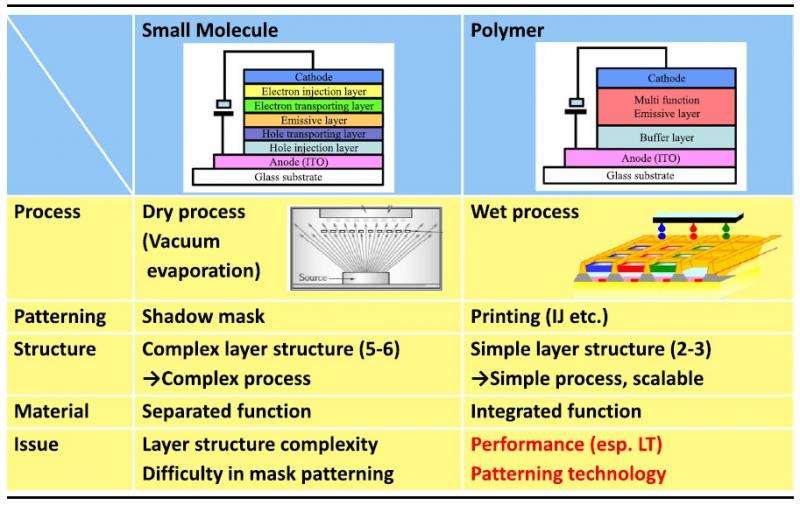Researchers review the state of printed organic electronics

While the world of electronics devices was radically different 30 years ago when Sumitomo Chemical (SC) began developing printed electronics technology, the company had already felt it was an area where they could make a significant contribution. Drawing on the company's decades of expertise in this field, Chizu Sekine, a researcher at SC, and colleagues prepared a review of the progress made in applying printed electronics to organic devices. The review has been referenced by several other papers since it was published in the journal Science and Technology of Advanced Materials in 2014, and this year it won the journal's best paper award.
"I think that the strong demand from the IoT or Trillion sensor network society is attracting us towards the development of printed electronics technology," says Chizu. "The key demands of these applications are (1) on-demand fabrication of various designs and (2) low manufacturing cost - printed electronics can give a solution to both these demands."
The review focuses on organic LEDs (OLEDs) and organic photovoltaic devices (OPV), which as Chizu explains provide useful examples of the state of the field. The review covers several milestones that have presented a gear change in the performance of these devices, such as the efficiencies achieved, and the ease of printing them. While Chizu suggests that materials development will be key to future progress, she adds that no single technology alone will lead to the commercialization of practical products. "I think that hybrid technology will be the most significant in future development."
On hearing of the award Chizu was surprised and pleased as the review had attracted more interest than at first expected. She says, "This is a good opportunity to empower our research group to win the challenge of organic printed electronics development over our competitors."
Background
Organic electronics
Organic compounds are a class of chemicals that contain carbon, with the exclusion of carbides, carbonates, cyanides and pure oxides of carbon. These include small carbon-based molecules as well as polymers. While most conducting materials are inorganic, the discovery of a number of semiconducting and conducting polymers in the 1950s and 1960s opened up the potential to develop organic electronic devices.
Organic materials tend to be cheaper than their inorganic counterparts, and have lower processing temperatures, which makes organic electronic devices less expensive to produce. They can also be flexible which has benefits for both the applications they can be used in and further reducing fabrication costs.
OLEDs
Electroluminescence – the emission of light in response to an applied voltage – was first demonstrated in a polymer by a group in Cambridge in 1989, and a similar phenomenon was observed almost simultaneously by researchers at Sumitomo Chemical. While at the time the external quantum efficiency of the emitted light was very low – around 0.1% - it inspired decades worth of research to develop organic OLED devices that could exploit the phenomenon more efficiently.
Today OLEDs can be produced in red, green, blue and white, and external quantum efficiencies of 5-10% have been achieved with device lifetimes that range up to several tens of thousands of hours. The fine image-quality, and ultrathin, and light-weight features of OLEDs have already led to their uptake by Samsung in the Galaxy range, although so far these are produced by an evaporation process.
OPV
Organic photovoltaic devices have the reverse working mechanism to OLEDs, producing an electric potential difference from incident light. This can be used for energy harvesting or sensing. Like OLEDs the use of organic materials means that devices can be made thinner and more lightweight, with lower fabrication temperatures.
Printed electronics
Evaporation deposition currently dominates organic electronic device fabrication. While the low temperature processing requirements for these materials allows some cost savings, printing fabrication techniques could allow further cost savings, particularly in scaled up production. Roll-to-roll printing allows significant cost and production efficiencies, but is only suitable for flexible materials, a requirement that is readily met by organic materials.
The increasing ubiquity of electronics has raised interest in techniques that allow on-demand fabrication of various designs and low manufacturing costs. Printed organic electronics meets these demands. Polymer OLED materials are already soluble and progress is being made towards making small organic molecules soluble with the introduction or replacement of substituent groups.
More information: Chizu Sekine et al. Recent progress of high performance polymer OLED and OPV materials for organic printed electronics, Science and Technology of Advanced Materials (2016). DOI: 10.1088/1468-6996/15/3/034203
Journal information: Science and Technology of Advanced Materials
Provided by National Institute for Materials Science


















